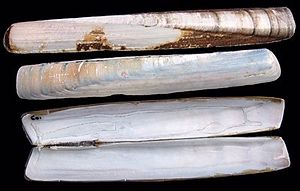Small razor clam
| Small razor clam | ||||||||||||
|---|---|---|---|---|---|---|---|---|---|---|---|---|

Ensis minor |
||||||||||||
| Systematics | ||||||||||||
|
||||||||||||
| Scientific name | ||||||||||||
| Ensis minor | ||||||||||||
| ( Chénu , 1843) |
The Small razor clams ( Ensis minor ) is a species of shellfish from the family of Pharidae , which also occurs in the North Sea.
features
The same-folding case is up to 17 cm long and up to 2.5 cm high. The length-to-height ratio is below 7. The dorsal and ventral margins run almost parallel and are almost straight to only very slightly curved. The front and rear ends are about the same height, the rear end can also be slightly higher. The ends are very flat and rounded to almost straight and are perpendicular to the longitudinal axis of the housing, sloping slightly downward on the outside. The case is extremely asymmetrical, the small vortices are near the front end. Front and rear ends gape constantly. At the front end the muscular foot emerges, at the rear end the relatively short siphons . The rear opening is diamond-shaped in cross section.
The long, narrow, brown to black ligament lies externally behind the vertebrae. In the right valve there is an elongated cardinal tooth and an elongated, posterior lateral tooth. In the left valve there are two bulbous cardinal teeth and two posterior, elongated lateral teeth, one above the other. The jacket bay is U-shaped. There are two sphincters. The anterior sphincter is elongated, dorsal, and longer than the ligament. The posterior sphincter, on the other hand, is small and rounded and set off from the mantle bay by about twice the diameter of the sphincter. The anterior sphincter is longer than the ligament.
The shell is comparatively thin and brittle. It varies in color from off-white, cream to gray with some reddish brown, pale purple or pale pink spots and bands. The outside of the housing has growth lines parallel to the edge and growth interruptions (coarser lines). The glossy, greenish to yellowish brown periostracum becomes darker and brownish towards the edges. Inside, the shell is whitish with a bluish or purple tint. The inside edge of the housing is smooth.
Similar species
In the small razor clam ( Ensis minor ), the rear sphincter muscle is closer to the edge of the housing than the anterior sphincter muscle on the dorsal edge of the housing, and in the pod clam at about the same distance.
Geographical distribution and habitat
The distribution area extends from Norway along the coasts of Western Europe to Morocco and the Mediterranean .
The animals live buried in sandy sediment mostly in less than four meters of water; but they also occur a little deeper up to 25 meters water depth. They stick with the front end down vertically in the sediment. The species is heavily fished in the Mediterranean.
Taxonomy
The species was first validly described by Jean-Charles Chenu as Solen siliqua minor . The name appeared in Lamarck's Histoire naturelle des animaux sans Vertèbrès as early as 1818 , but there it is a nomen nudum without a detailed description. The species is now placed as an independent species in the genus Ensis Schumacher, 1817.
supporting documents
literature
- Fritz Nordsieck : The European sea shells (Bivalvia). From the Arctic Ocean to Cape Verde, the Mediterranean Sea and the Black Sea. 256 p., Gustav Fischer Verlag, Stuttgart 1969 (p. 146)
- Guido Poppe. Yoshihiro Goto: European Seashells Volume 2 (Scaphopoda, Bivalvia, Cephalopoda) . 221 pp., Verlag Christa Hemmen, Wiesbaden 1993 (2000 unc. Reprint), ISBN 3925919104 (p. 107)
- Roelof M. van Urk: De Nederlandse Ensis-soorten. Basteria, 28 (3/4): 60-66, 1964 DPF
- Rainer Willmann: Mussels of the North and Baltic Seas. 310 p., Neumann-Neudamm, Melsungen 1989 ISBN 3-7888-0555-2 (p. 170 Ensis minor is combined with Ensis siliqua )
On-line
- Marine Bivalve Shells of the British Isles: Ensis minor (Chenu, 1843) (site of the National Museum Wales, Department of Natural Sciences, Cardiff)
- Marine Species Identification Portal: Ensis minor (Chenu, 1843)
Individual evidence
- ↑ a b Jean-Charles Chenu: Illustrations conchyliologiques ou description et figures de toutes les coquilles connues vivantes et fossiles, classées suivant le système de Lamarck modifié d'après les progrès de la science et comprenant les genres nouveaux et les espèces rècemment découvertes. Tome 2. Paris, A. Franck, 1842. Plate
- ↑ Donatella Del Piero, Roberto Dacaprile: The alternating recruitment pattern in Ensis minor, an exploited bivalve in the Gulf of Trieste, Italy. Hydrobiologia, 375/76: 67-72, 1998 preview on Google Books
- ^ Jean-Baptiste-Pierre Antoine de Monet de Lamarck: Histoire naturelle des animaux sans vertèbres. Histoire des Mollusques. Tome cinquième. SI-IV, 600 pp., Deterville & Verdière, Paris 1818. Online at Google Books (p. 52)
- ↑ MolluscaBase: Ensis minor (Chenu, 1843)
